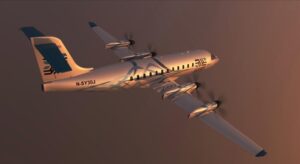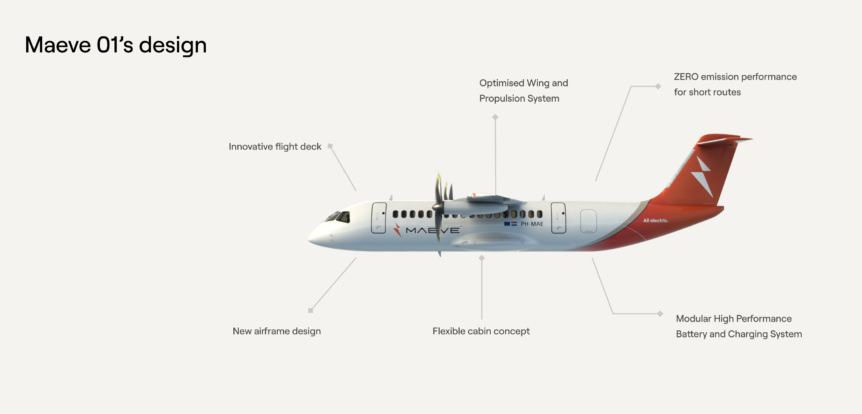Electric aircraft sales told the tale at this year’s Paris Air Show. European and American firms sold, or received letters of intent for, hundreds of craft, especially of interest in the electric, hydrogen, and hybrid categories we’ll discuss here. We will have subsequent entries on other craft of interest at the show and the commercial possibilities they encompass.
Afrijet’s electric intentions
French airframer Aura Aero signed a Memorandum of Understanding (MOU) for “multiple electric aircraft” at the Paris Air Show. This came a day after a Philippine-based Asian aerospace firm signed a Letter of Intent for three electric aircraft with Aura Aero.
The 19-passenger, eight motor, ecologically friendly aircraft has an all-up weight of 8.6 tons and a hybrid cruising speed of 250 knots true air speed (288 mph). Its pressurized cabin can alternately carry 1,900 kilograms (4,180 pounds) of cargo with a total volume of 21.5 cubic meters (759.3 cubic feet). Total operating costs will run only one-tenth of a euro per seat kilometer.
According to simpleflying.com, two turbogenerators running on 100-percent Sustainable Aviation Fuel (SAF) will charge “four electric battery packs in an 800-[Volt] network that will also power the [motors]. Boasting a range of 1,600 kilometers (1,000 miles) in hybrid mode, the airplane can manage only 166 kilometers (103 miles) on batteries alone.
This Electric Regional Airliner (ERA) is claimed to be able to “reduce energy and maintenance costs by at least 50 percent and carbon emissions by up to 80 percent compared to the current new generation of conventionally-powered aircraft that have fit in the 19-seater category.”
The ERA, hailed as “the Tesla of aviation by its builders, is due to fly in 2026, receive its type certification in 2028 and enter into commercial service before 2030, according to Aura.
EcoPulse Hybrid
We reported on this craft four years ago during its early concept phase. Now it has appeared at the Paris Air Show having completed ground testing and a total of 27 hours of flight tests with the electric propellers feathered. The demonstrator flew 10 hours with two of its six motors installed and more with four motors. It showed up at Le Bourget with all six in place.
The EcoPulse is a Daher TBM with a big turbo-prop/generator driving the six electric motors on its wing’s leading edges. Developed by Daher, Safran and Airbus, EcoPulse will be used to evaluate its hybrid distributed propulsion system for increased efficiency, and the reduction of CO2 emissions and noise pollution.
The demonstrator has so far amassed around 27 hours of flight time with the electric propellers feathered. “From this demonstration program, we plan to develop our future product roadmap and basically spec the hybrid aircraft we intend to produce by the end of our five-year plan. We expect by the end of 2027 to be able to offer our first hybrid aircraft to the market.”
Airbus will optimize the aerodynamics and the battery system: Safran will develop the hybrid propulsion system.
Maeve Aerospace
Graham Warwick writes in aviationweek.com the Dutch startup plans to move from conceptual design to crafting a full-scale powertrain demonstrator, “from battery pack to electric motor.” The company wants to run the powertrain by mid-2024 and enter service by 2030.
Basing range estimates on batteries with an energy density of 500 Watt-hours per kilogram, the company is working with “with silicon-anode battery maker Amprius, which has announced it is developing a 500 Wh/kg.” cell. Such a battery pack could be charged in 35 minutes and give the 44-passenger 01 a range of 460 kilometers (250 miles).
In December, the European Innovation Council selected Maeve to receive “a potential”€17.5 million ($19.1 million) with apparent matching funds coming from Maeve. Those funds may be forthcoming since Maeve signed letter of intent with FlyWithLucy, a Dutch plane-sharing company for ten 01s, and during the air show, a purchasing agreement for 35 aircraft with New Zealand-based Air Napier, a charter and freight service. Maeve and its customers all seek to clear the air with electric flight.
The AirCraft Company’s Pangea
An ocean and continent away, Pangea, a product of The AirCraft Company in Wichita, Kansas, posits the following questions. “What if we produced an airplane that could reduce direct operating costs to airlines by 90 percent, address disappearing service to small airports, improve access for people with reduced mobility, and have zero to low greenhouse gas (GHG) emissions?” This teaser extols the virtues of Kansas while hinting at an aircraft.
The AirCraft Company hopes to field its SY30J Pangea into service by 1929, with 400 kilometers (248.5 miles) range from 350 Wh/kg batteries. CEO Mario Asselin notes a range extender could increase that range to 800 kilometers (497 miles). His last name extends to Asselin, “a Wichita-based aviation services company.” Asselin and co-CEO Sylvie St-Georges have self-funded development of the craft, and have completed conceptual design and are beginning supplier selection, according to Aviation Week’s Graham Warwick.

The AirCraft Company’s Pangea seems designed to offer thoughtful accommodations for passengers
Future travelers may bless the co-CEOs since they plan to lay out their craft “around the larger size of U.S. passengers, with 20-in.-wide seats…. The cabin is also designed to ease access for passengers with reduced mobility, with a first seat row, wider aisle and a lavatory that can accommodate a wheelchair.” That acknowledgement of real human needs may help cut down on air rage incidents on Pangea flights.
An Elixir with a Chaser of Clean Air
Elixir Aircraft makes two-seat light sporting aircraft, low-wing monoplanes with excellent performance on a range of the ubiquitous Rotax engines. The company now claims it’s entered its “4th Generation” of aircraft production techniques, relying on a “OneShot composite assembly that “removes rivets, glue and screws, making ribs and spars belong to the past!”
Rotax engines are economical to run, but still use fossil fuels. To counter tha, Exlixer showed a 140-horsepower Turbotech TP-90 turbine-powered prototype, part of a family of eco-friendly engines which will eventually include a planned cryogenic hydrogen propulsion system for light aircraft supported by the BeautHyFuel research program. This is all part of the CORAC civil aviation research council supported by Safran, Daher and Air Liquide Air Liquide is designing the hydrogen fuel tank.
The Turbotech can also run on SAF, enabling low or zero emission flight depending on the fuel source.
Elfly Noemi
Eric Lithun, Chief Executive Officer, and Erik Sandal, Chief Financial Officer, and Tomas Brødreskift, Chief Technical Officer, form the trio heading Elfly. Tomas even built a two-place hybrid-power amphibian in his garage, and is a skilled designer and builder.
The team backs the Nordic Racing Team, their converted Cassutt racer now battery powered and ready to run in Air Race E competitions. In the General Aviation arena, they plan on being the European distributor’s for Bye Aerospace’s eFlyer 2 and eFlyer 4.
Pride of place goes to their nine-passenger, twin-motor electric seaplane, for which they have grand ambitions. Starting in Norway and later expanding into the European market, “We want people to travel emission-free from city center to city center at a fraction of the time.” Not to mention in emission-free comfort that would lure Greta Thunberg into hopping a flight.
eb site that not having to build a complex infrastructure is a point in their favor, bays and harbors being flight ready. “Small and flexible sea terminals will facilitate the boarding and unboarding of our passengers,” according to Elfly. A map of their projected seaports, stretching from Stavanger in the south to Stryn in the north includes coastal and inland waterways.
Unpressurized and flying at low altitudes, the Noemi will be powered by motors totaling up to 1 megawatt (1,341 horsepower) and fly up to 200 kilometers (109 nm) at speeds of up to 250 knots. Future Flight.com projects, “Downtown-to-downtown travel time could be cut to under an hour, giving welcome alternatives to a road trip taking at least four and a half hours or a ferry. In addition to its long coastline, Norway has more than 1,000 fjords and 450,000 lakes.”
A Bumper Crop Awaiting Certification
This is a small sample of the fifty electrically-powered craft showing up at this year’s grand air show. We’ll look at rotary-winged and multi-copter types in our next installment.

